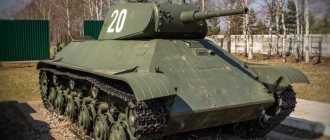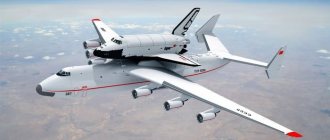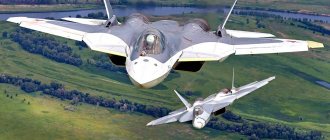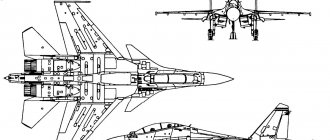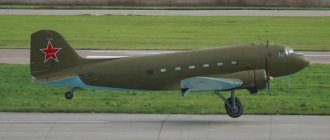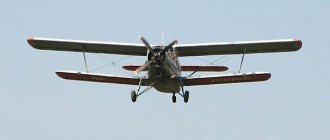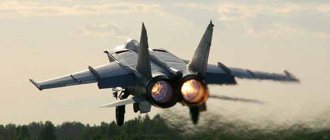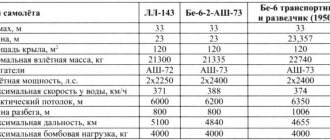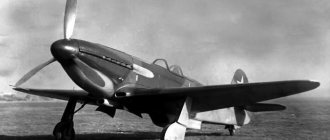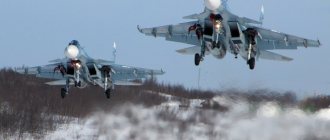History of creation
The Su-34 fighter-bomber (NATO code Fullback) with an expanded functional purpose was created as a successor to the well-known Su-24 bomber and attack aircraft. When creating a new vehicle, the factor of the potential enemy’s use of fourth and transitional to fifth generation fighters was taken into account.
Initially, the design was developed according to the “longitudinal triplane” design, which was well studied at the Sukhoi Design Bureau. At the same time, the dimensions of the aircraft, compared to its predecessor Su-24, were increased, which made it possible to increase the range and combat load.
A new feature was the flattened shape of the nose cone, which made it possible to implement a cabin layout with a parallel arrangement of two crew members.
Due to the characteristic shape of the front part of the fuselage, the Su-34 aircraft received the nickname “Duck” or, more commonly, “Duckling”.
This layout was borrowed from an unfinished project of a training aircraft for training pilots of shipborne carrier-based aviation.
Development of the project under the code T-10B began in the summer of 1986 under the leadership of the general designer of the design bureau M.P. Simonov, and already in the spring of 1990 the first flight of a prototype of a promising machine was carried out. To build the prototype, a production copy of the Su-27UB aircraft was used.
Further development slowed down due to the collapse of the USSR and the crisis situation in the Russian Federation. The general public saw “Duck” at the end of winter 1992 at an exhibition in Belarus.
The aircraft was then demonstrated at annual exhibitions in 1992 and 1993 in Zhukovsky. The first international display of the Su-34 took place at the Le Bourget air show in the late spring of 1995.
Subsequent static and flight tests of the aircraft took another 9 years, during which six pre-production aircraft were used. State tests of the Su-34 began 20 years after the start of design work and lasted almost five years.
At the same time, production of single serial vehicles was underway, which took part in the conflict in South Ossetia. The official adoption of the Su-34 fighter-bomber into service with the Russian Air Force took place only in March 2014.
Currently, there is a systematic increase in production volumes of the aircraft, which should completely displace the Su-24 from combat units by 2022.
As of fall 2022, at least 108 copies of the bomber have been produced and shipped. Based on the main model of the Su-34 aircraft, there is only one modification - the Su-32, intended for export.
A brief history of the appearance and testing of the Su-34 aircraft
The design of a new vehicle called the Su-34 was completed in early 1990. After the development was completed, the production of a prototype began. The new machine was created by converting the Su-27UB training aircraft. It was equipped with all the equipment and parts of the structure that the designers had thought of. This work was carried out at the Sukhoi aircraft plant, workers replaced the nose, engine nacelles and air intakes.
The converted aircraft first flew in the spring of 1991. The Su-39 fighter-bomber was fully ready in the winter of 1993. A year later, this machine was presented to the public in Paris at an air exhibition. The plans of the manufacturers clearly show the idea of selling it on world markets, since at international exhibitions it has an English abbreviation. Some vehicles are painted in nautical colors, which allows them to be used over water areas and placed on aircraft carriers.
Airframe and landing gear
The airframe of the Su-34 front-line bomber has an integrated circuit layout and is built according to a longitudinal triplane design. The trapezoidal wing has a leading edge angle of 42 degrees.
An additional horizontal tail is installed in front of the wing, which can be rotated in a wide range as a whole. The power plants were located in two nacelles installed in the center section of the aircraft.
The inlet air channels were not adjustable, since the main purpose of the Su-34 was to carry out bombing and missile strikes while flying at low altitudes. The nose cone of the fuselage received an elongated shape, which made it possible to place an on-board radar with a small-sized antenna.
For takeoff and landing of the aircraft, a landing gear with a steerable nose strut is used, equipped with two parallel wheels and two main supports located on the wings.
The wing strut niches are located in the center section, directly behind the engine nacelles. When cleaning, the stand, equipped with a tandem installation of two wheels, rotates around its axis.
The landing gear design was developed taking into account the possibility of using the Su-34 aircraft from unpaved airfields.
For additional braking during landing there is a double parachute located in a container on the top of the fuselage. Before releasing the canopies, the container is pulled out of the Su-34 fuselage.
Crew quarters and controls
Two Su-34 crew members sit next to each other in a pressurized cabin equipped with an air-conditioned microclimate system. The use of oxygen supply in the cabin allows flights without masks up to an altitude of 10,000 m.
On the left side of the cockpit is the pilot of the aircraft, next to him is the navigator, who is also the operator. The parallel placement of workstations made it possible to improve crew interaction and reduce fatigue during long combat missions.
To ensure protection, the cabin body is made by welding from titanium plates with a thickness of up to 17 mm. The canopy is made of armored glass of various thicknesses.
Access to the cabin is through the niche of the front landing gear. For this purpose, a folding ladder is installed in the depths of the niche.
In case of emergency situations on board the aircraft, the pilot and navigator can use the K-36DM ejection seats.
Ejection is possible not only in flight, but also in the parking lot or when taxiing a Su-34 aircraft at the airfield.
The seats have a massage system that improves comfort for crew members during long flights.
The control system uses a digital installation that monitors the current values of overloads and angles of attack. Based on this data, the system automatically compensates for aircraft vibrations using the additional front tail rudders.
When flying at low altitudes, the active safety system is automatically activated, which does not allow the aircraft to enter dangerous flight conditions. The control design of the Su-34 aircraft uses a navigation system that determines position using satellites. Additionally, the position can be clarified via the radio navigation channel.
Features of the Su-34
When designing the Su-39, all the experience of aircraft design at the Sukhoi Design Bureau was taken into account, which made it possible to achieve such high results. The cockpit is made as a monolithic armored capsule. In addition to the cabin, all vital systems and assemblies are equipped with armor, which increases the survivability of the vehicle. The entire armor of the aircraft weighs almost 1.5 tons. To increase survivability, the aircraft is equipped with active protection systems, which are the same as those in the Su-27 aircraft.
To more effectively carry out combat missions, all processes are carried out by the pilot and his assistant navigator. The cockpit is quite comfortable and spacious, you can even stand upright in it. In addition, the plane is equipped with a toilet and a special cabinet for heating food. The cockpit is capable of maintaining a normal microclimate, which allows flights at an altitude of 10 kilometers without the use of oxygen masks. All these systems contribute to better performance of the aircraft’s pilots even during long flights, which can reach 10 hours.
The Su-34 aircraft was created to destroy both ground and water targets of the enemy. In addition, it is capable of hitting moving targets even of small size. As for air targets, the aircraft has the ability to destroy air targets at any time of the day or night under any meteorological conditions.
The development and improvement program for the Su-34 aircraft is the most promising, since the aircraft has excellent flight and tactical characteristics.
Engines
The power plant used on Su-34 aircraft is two AL-31F turbojet engines with a dual-circuit design. This scheme made it possible to increase the operating parameters of the engine and reduce specific fuel consumption.
In the first circuit of the engine, two compressor stages and two turbines are installed on one shaft. Between the compressor and the turbine there is a combustion chamber.
The second circuit is a shell built around the body of the first circuit. Using an axial fan, atmospheric air is forced into the gap between the circuits, which is supplied to the afterburner located behind the primary circuit turbine.
Depending on the modification, the engines of the AL-31F family are capable of developing thrust from 12,800 to 14,500 kgf. Maximum thrust is achieved in extreme boost modes and can not be maintained for long.
This mode reduces engine life and is not recommended for frequent use.
On board the Su-34 bomber there is an autonomous unit driven by a small gas turbine engine. This system is used to start main engines when operating from field airfields.
Characteristics
The overall dimensions are approximately the same as the Su-27 (14.7 m wingspan, 22 m length and about 6 m height). Normal take-off weight is 39 tons, which is more than a heavy interceptor, but less than most tactical bombers. However, it can exceed 44 tons at maximum load. The plane reaches speeds of up to 900 km/h at an altitude of 11 thousand and 1400 km/h at the surface. The combat radius ranges from 600 to 1,130 km, depending on the amount of fuel and weapons, the ferry range reaches 4,500 km. Ceiling (practical) – 17 thousand. The maximum operational overload corresponds to the requirements for maneuverable interceptors - 7 g.
Fuel system
The fuel supply on board the Su-34 aircraft is located in several fuel tanks located in the fuselage, wing section and console parts of the wings. The number of tanks and their exact location differs according to data from various sources.
All tanks are interconnected by a pipeline system with transfer pumps. This allows fuel to be produced evenly during the flight, maintaining the aircraft's alignment within specified limits.
Kerosene is taken into the fuel supply equipment of engines from a special supply tank. The inner surface of all tanks is covered with a protector based on a polyurethane foam mixture.
If the tank of a Su-34 is punctured with such protection, the formation of fuel-air mixtures, which could lead to a fire on board, is prevented.
To increase the range, it is possible to install jettisonable fuel tanks on external mounts. The maximum volume of hanging tanks is up to 3000 l.
The second way to increase flight range is an in-flight refueling system.
The role of a refueling tanker can be an Il-78 type vehicle or another Su-34 aircraft equipped with a special suspended unit for refueling. Refueling can be done at night by illuminating the hose with two headlights located in the bow.
Real state and plans
Today, the number of Su-34 aircraft in service with the Aerospace Forces is at least 83 units. Of these, 75 are serial samples, and another 8 are intended for development and testing. In particular, four bombers are located at the flight test center named after. Chkalov in the Astrakhan region (Akhtubinsk). In active military units (air regiments) throughout the country - from Murmansk to Rostov and from Khabarovsk to Voronezh - these aircraft are part of mixed units. According to the contract concluded with the Ministry of Defense in 2008, the delivery of 32 units was planned for a total amount of over 33 billion rubles, from which we can conclude how much the Su-34 aircraft costs (a little over a billion each). In 2008, the order was increased by another 92 bombers. The Novosibirsk Aviation Plant (NAPO) became the production base. Currently, mass production of machines has been organized, which significantly reduces costs.
In the coming years, the still good, but obsolete Su-24 in air regiments will be completely replaced by the Su-34 aircraft. The technical characteristics of the new model meet the standards of the “fourth plus two plus” generation, which will ensure its long service in the Russian Air Force.
Armament
A single-barrel 30 mm cannon of the GSh-301 type with 180 rounds of ammunition is installed in the wing and fuselage fairing. The ammunition boxes are located inside the armored cockpit.
The main armament of the Su-34 bomber is located on 12 suspension points installed under the fuselage, engine nacelles and cantilever parts of the wings. The total load weight can reach 8000 kg (up to 12000 kg in overload with a flight range of 1000 km).
There are several options for placing missile weapons on board the Su-34 aircraft:
- 8 missiles of the R-27 type, installed on the fuselage and wing consoles;
- 8 medium-range missiles of the R-77 type, placed on consoles;
- 6 short-range missiles of the R-73 type, mounted on the wings.
High speed and modern radar equipment allow the Su-34 aircraft to fight any targets. To carry out precision strikes against ground- and surface-based targets located at distances of up to 250 km, the following combinations of aircraft weapons are used:
- Up to three units of a tactical missile system of the X-59M type, equipped with a television guidance system;
- 6 air-to-ground missiles of the Kh-29, Kh-25M or S-25L types;
- Up to six missiles designed to combat enemy ships (range from 70 to 250 km);
- Six X-31 model missiles designed to destroy radar stations;
- Three guided bombs, weighing 1500 kg each;
- Six guided 500 kg bombs;
- Four torpedoes;
- For reconnaissance, it is possible to suspend a container containing 70 sonar buoys;
- 16 high-explosive bombs weighing 500 kg, or 36 bombs weighing 250 kg, or 48 bombs weighing 100 kg.
To detect targets, the Su-34 uses a head radar station, which is capable of detecting large ground targets at distances of at least 200 km.
The detection range of air targets ranges from 90 km (fighter type vehicle) to 250 km (large transport aircraft). The radar allows simultaneous observation of 10 targets and firing at four of them.
A second radar is installed at the rear of the Su-34 fuselage, warning of an attack from behind and allowing for directed missile launches in the direction of the rear hemisphere. The range of the rear radar is small and does not exceed 12...15 km.
Design
Forward looking radar
The radar station of the Su-34 Sh-141 aircraft is designed to detect ground and air targets. Detection range:
- large ground targets up to 200-250 km, - typical ground targets up to 150 km, - with target type identification as “potential tanks and tracked infantry fighting vehicles” up to 75 km, - large air targets without stealth technologies such as “transport aircraft” is up to 250 km; small air targets of the fighter type are up to 90 km.
The radar supports tracking up to 10 targets (simultaneously) and firing up to 4 targets (simultaneously), and is also designed to assist the guidance of air-to-air missiles with its own radars by “target illumination” for the RVV-AE and R-27. For the R-73 close-range missile - up to 20-40 km, with an infrared seeker, the radar provides the initial coordinates of the target.
The radar has a function for flying at extremely low altitudes with automatic terrain following TFR.
Rear-view radar
The rear-view radar is located in a container between the engines and allows you to detect a Su-34 attack in the rear hemisphere with missiles, while as a countermeasure, the rear-view radar supports the firing mode of the attacking fighter by targeting a special RVV-AE air-to-air missile launched from the Su-34 itself rear hemisphere to attack an attacking fighter without wasting time on maneuvering to destroy it.
Since a rear-view radar with the ability to launch missiles into the rear hemisphere is a rather unique technology, which, according to expert opinions and published specifications, the most common (F-15, F-16) and even promising (F-22, Eurofighter Typhoon) fighters do not have -NATO bombers, many experts are debating the reality of its existence and performance.
Many experts believe that the rear-view radar is in an unfinished stage, others believe that the radar has not yet been adopted for service. Thus, a photo of the assembly of the Su-34 with the radio-transparent cover removed, under which two miniature panels are visible, was published in the open press. A similar device is visible in other photos. However, the purpose and affiliation of these devices to any aircraft systems is not indicated.
At the MAKS-2001 exhibition, fragmentary information about the Kopyo-DL rear-view radar was provided. According to the performance characteristics of the “Spear-DL” in the 2001 version, a miniature radar panel with a diameter of about 30 cm, however, ensured control of missiles in the rear hemisphere and at a distance of 6-14 km at angles of +/- 60 degrees.
Many analysts believe that the N012 radar is used as a rear-view radar, and even published a graph of its sensitivity, which was presented by NIIP. Tikhomirov to Western potential buyers at the Singapure Air Show 2008.
Outboard reconnaissance equipment
In the variant of using the Su-34 as a reconnaissance aircraft, the use of suspended equipment is provided - the suspended universal reconnaissance container (UCR) "Sych", which is designed in three versions, depending on the type of reconnaissance:
— radio engineering; — radar; — optical.
Effective reflective area
The aircraft was developed taking into account modern requirements for reducing ESR. For this purpose, composite materials were used in the production of the aircraft to reduce the level of reflection of radar waves due to radio-absorbing coatings; when designing the integrated aerodynamic design, aerodynamic ridges (ventral fins) were excluded and the geometry of the airframe was specially calculated.
According to representatives of the OKB im. P.O. Sukhoi Su-34, when flying at low altitudes, has a degree of radar signature at the level of a cruise missile.
Electronic warfare and suppression of air defense systems
To actively counter enemy radar guidance stations if detected, the Su-34 is equipped with an electronic warfare system, which the Su-34 reduces the likelihood of being hit by radar-guided systems by about 30 times. The equipment of the aircraft complex is close to that of specialized electronic warfare aircraft. The power of the electronic warfare system on the Su-34, according to Western experts, is approximately similar to the level of equipment on the EF-111A and EA-18G aircraft.
The Su-34 electronic warfare system has external radar radiation receivers and can use Khibiny electronic warfare modules (product L-175V) or L005-S Sorptsiya-S.
To fire at the radar of enemy air defense systems, the Su-34 can use Kh-58, X-15P, Kh-31P missiles at ranges of up to 120-160 km and Kh-31PD at ranges of 180-250 km.
The practical effectiveness of the electronic warfare system was tested during the military conflict in Georgia, where the Su-34 was used as an electronic warfare aircraft.
Means for guiding bombs and missiles at ground targets
To use aviation weapons, the aircraft is equipped with a sighting system that allows you to search for and hit targets using a radar system. One of the systems of the complex is the Platan optical system, which is used to target air-to-ground missiles of the Kh-29L type, KAB-500-L and KAB-1500-L guided bombs with laser seekers that require target illumination. Versions of the Kh-29T missile and KAB-500Kr bombs do not require further guidance by the Su-34 complex after receiving the initial coordinates of the target; guidance to the target then occurs through recognition by a TV camera in the seeker.
Used for destruction with conventional weapons (conventional (unguided) bombs, unguided missiles), the aircraft's sighting system provides accuracy comparable to the use of expensive high-precision weapons. This effectiveness of the use of conventional weapons was noted by NATO experts based on the experience of using the Su-34 in Syria. At the same time, NATO experts note the relatively low cost of bombing compared to the use of guided bombs (The cost of BGL-type bombs is about $100,000 per unit, their Russian analogue KAB-500S costs about 3 million rubles, which is on average 3 times more expensive than a conventional bomb. Accumulated In the Russian Federation, large reserves of conventional bombs, inherited from the USSR, make it possible to reduce the cost of high-precision combat use of the Su-34.
The aircraft’s capabilities make it possible to use NATO bombs and missiles using the Ural Optical-Mechanical Plant named after E. S. Yalamov (UOMZ) produced under the license of the French Thales Group Damocles module. This module allows the use of high-precision destruction systems of NATO standards. The development of this module in collaboration with Thales Group for Damocles was caused by the need to fulfill a contract with Malaysia for the supply of Su-30 aircraft, but was subsequently intended for use on the Su-34. The module, designed as a suspended container, allows the use of BGL series guided bombs, optical detection of armored vehicles at a range of up to 27 km, and control of laser channel guidance of guided bombs and missiles at a range of up to 16 km. In addition to using the NATO ammunition nomenclature, Damocles technologies are adapted to the use of domestic ammunition.
Su-34 cockpit
In order to increase the survivability of the aircraft and the protection of the crew, the outer casing of the aircraft cabin is made of an armored shell made of titanium alloy. During its development, the shortcomings identified during the combat use of Su-25 aircraft were taken into account[5]. The thickness of the Su-34 armor is 17 mm, which is much thicker than the Su-25 armor, which is designed to withstand 12.7 mm shells. The armor weight of the Su-34 is 1480 kg, which is almost 1.5 times more than that of the Su-25. A distinctive feature of the armor of the Su-34 from the Su-25 is that the armor is made entirely of titanium alloy, without aluminum or steel plates. The cabin has armored glazing.
The aircraft cockpit is equipped with two K-36DM ejection seats, allowing ejection over the entire range of altitudes and flight speeds, as well as from the ground (including taxiing). The entrance to the cabin is made through the lower hatch along the steps. The hatch is located near the front landing gear.
Crew life support systems
To ensure efficient operation of the crew during flights at maximum range and duration (with additional external fuel tanks for a range of up to 7000 km), the Su-34 is equipped with the following life support systems that increase comfort:
— sewage disposal device — dry closet; — a sealed cabin with an oxygen system, ensuring flights without oxygen masks up to an altitude of 10,000 m; — cabin air conditioning and heating system; — kitchen compartment (kitchenette), including a microwave oven and thermoses for storing rations and water; — space located behind the seats, allowing you to stand up to your full height; — electric massage system built into the chairs; — a system for projecting instrument readings onto the windshield, allowing you to monitor flight parameters while outside the seat.
Means of ensuring work from unprepared airfields
The aircraft is equipped with a TA14-130-35 auxiliary gas turbine power unit, which allows autonomous engine starting without the use of ground-based launch equipment. The presence of an autonomous power source allows the aircraft to be used from unprepared airfields that do not have launch equipment, which significantly expands the combat radius.
Engine and flight mode “supercruise”
The aircraft is equipped with two AL-31F-M1 turbofan engines, each having 13,300 kgf of thrust and allowing it to reach speeds of up to 1900 km/h. The ongoing modernization of the aircraft involves equipping the aircraft with new engines of the AL-41F type, which provide thrust in afterburning modes of up to 14,000 kgf and 14,500 kgf in the “extreme afterburner” mode each, and also allow flights at supersonic speed in the “supercruise” mode) . This mode provides an undoubted advantage over aircraft that do not have this mode, due to the high fuel consumption in afterburner modes, which are forced to maintain supersonic flight speed.
Automatic fire extinguishing system
To increase survivability, the aircraft is equipped with an automatic fire extinguishing system, as well as means of duplicating and shielding all systems. Fuel tanks are protected from fire and explosion by being filled with open-cell polyurethane foam, the technology of which is based on isolating fuel from air due to the “encapsulation” effect, which prevents the formation of a flammable vapor-air mixture if the fuel tanks are damaged.
Accidents and flight incidents
On June 4, 2015, at about 16:30, while landing at the Buturlinovka airfield (Voronezh region) after performing a planned training flight, a Su-34 front-line bomber from the 47th separate mixed aviation regiment of the 105th mixed aviation division of the 1st crashed. Russian Air Force and Air Defense Command. Since December 2013, the regiment has been temporarily based at the Buturlinovka airfield for the period of repair of the runway at the regiment's regular airfield in Baltimore (Voronezh). The plane skidded off the runway and overturned. The plane's crew was not injured.
Tactical and technical characteristics and combat use
The versatility of the Su-34 aircraft makes it a unique machine that has no direct analogues in the armed forces of other states. The closest in purpose and tactical-technical data are the American multirole fighter McDonnell-Douglas F-15E and the modernized Russian Su-24M2.
| Su-24M2 | Su-34 | F-15E | |
| A country | RF | RF | USA |
| Permissible take-off weight, kg | 39700 | 44360 | |
| Wingspan, mm | 17640 | 14700 | 13050 |
| Length, mm | 24590 | 22000 | 19430 |
| Height, mm | 6190 | 5930 | 5630 |
| Engine thrust, kg | Two for 11250 | Two for 14500 | Two for 13250 |
| Maximum speed at altitude, km/h | 1700 | 1900 | 2655 |
| Maximum speed at sea level, km/h | 1400 | 1400 | 1450 |
| Range, km | 4270 | 4500 | 4445 |
| Application radius, km | Up to 560 | Until 1130 | 1270 |
| Ceiling, m | 1100 | 17000 | 20000 |
| Operational overload | 6,5 | 7 | 9 |
The first experience of using the Su-34 aircraft in combat conditions was the 2008 conflict in South Ossetia. Bombers were used to a limited extent to combat Georgian radar installations by jamming them.
In addition, at least one missile was launched, which destroyed a radar installation of the Georgian army. During the fighting in Syria, several Su-34 bombers were used to carry out missile and bomb attacks on terrorist positions.
The aircraft are used in conjunction with fighter cover consisting of Su-30 and Su-35 aircraft.
Strikes are carried out using high-explosive and guided bombs weighing 500 kg, as well as medium- and short-range missiles. According to information from Arab media, one Su-34 was shot down by anti-aircraft fire.
Advantages and disadvantages
Advantages of the Su-34:
- high maneuverability, allowing you to quickly change position in an attack and evade enemy attacks;
- ability to carry a large combat load;
- large range of action;
- effectiveness in detecting and, accordingly, destroying armored vehicles and other mobile ground targets;
- variety of weapons used, including anti-ship, anti-submarine, anti-radar;
- low cost of the aircraft, ease of repair and maintenance due to the interchangeability of a number of units with aircraft of the Su-27 family.
The Su-34 is superior to the aforementioned F-15E Strike Eagle in takeoff weight, fuel weight, range, protection and crew comfort, while only slightly inferior in maximum speed.
It is known about the shortcomings of the fighter-bomber that in 2013 the Russian Ministry of Defense officially announced that they had been eliminated.
Prospects for improvement
One of the promising areas for improving the Su-34 is the installation of more powerful power plants. Instead of the AL-31F, it is planned to use AL-41 engines, which are capable of developing forced thrust up to 20,000 kg.
Another direction of development of the Su-34 is the expansion of weapons and guidance systems. To expand the capabilities of on-board radar and optical equipment, it is possible to install additional modules in hanging containers.
This equipment has been developed for more than 10 years as part of the Sych project. No less promising are developments in the field of new missile weapons. One example is the modernized Kh-59MK2 missile, designed to destroy ground targets.
Interesting Facts
One of the first pre-production copies of the Su-34 made a non-stop flight along the Moscow-Sakhalin route with several in-flight refuelings, which confirmed the possibility of performing long flights on this type of aircraft.
There is a passage between the seats to accommodate the Su-34 crew, which can be used as a place to sleep and rest. Behind the seats there is free space sufficient to accommodate full-length crew members.
In this case, instrument readings are displayed on the glazing of the canopy, which allows you to monitor them from the rear of the cabin.
All Su-34 front-line bombers have a kitchen equipped with vessels for storing water and food supplies and a microwave oven.
There is a bathroom at the rear of the cabin. The Su-34 is depicted on a souvenir silver coin with a denomination of one ruble, issued by the Bank of Russia in the series “Armed Forces of the Russian Federation”. The coin was released in a limited edition (5 thousand pieces) in 2009.
In the spring of 2016, a pair of Su-34s were used to clear ice jams on the Northern Dvina River. Air bombs weighing 250 kg were used to destroy the ice.
Production
As of 2011, 22 Su-34s were manufactured, including prototypes (b/n 42-48) and serial ones (b/n 01-09 and b/n 01-05, 10). Aircraft with license plates 46, 47, 01, 03 are being tested at the 929th GLITs (Akhtubinsk); b/n 02, 04-09 in the 968th IISAP (Lipetsk); w/n 48 participates in the exposition of the MAKS air show (Zhukovsky); prototypes with no. 42, 43, 44, 45 are no longer involved in the flight test program. Board numbers from 01 to 05 produced in 2006-2009. will remain in GLITs (2 boards) and TsBPiPLS (3 boards); no. 06, 07, 08, 09 produced in 2010, as well as no. 01, 02, 03, 04, 05, 10 produced in 2011 - at the 7000th AB Baltimore (Voronezh).
On December 12 and 22, 2011, six new Su-34 bombers arrived at the Baltimore air base in Voronezh, making this base the first among the Air Force combat units to receive these machines.
In 2008, a 5-year contract No. 319/3/1-ЕОЗ dated November 10, 2008 worth 33.6 billion rubles was signed for the supply of 32 aircraft; work began in 2009. On March 1, 2012, Russian Defense Minister Anatoly Serdyukov and General Director Igor Ozar signed a state contract for the supply of 92 Su-34 front-line bombers by 2022.
In total, the Air Force intends to purchase 124 aircraft of this type.
Serial production of the aircraft has been established at the Novosibirsk Aviation Plant. The cost of one Su-34 aircraft is about 1 billion rubles.
At the beginning of 2008, NAPO announced that it was the first in Russia to organize the mass production of the latest Su-34 front-line bombers. The total cost of technical weapons will be more than 50 million euros.
Automation of the process should lead to the fact that up to 20 cars can be assembled at the same time, and aircraft repairs will take place twice as fast.
The reconstruction of the workshop was carried out throughout 2007. As part of the state defense order, Sukhoi Holding carries out the repair and modernization of Su-24M front-line bombers and the assembly of the latest Su-34 fighter-bombers.
Representative of the Sukhoi holding:
| Currently, NAPO named after Chkalov is implementing a large-scale technical re-equipment program: in 2008-2009, it is planned to purchase 43 high-performance machining centers for a total amount of about 2 billion rubles, which will allow the enterprise to reach a qualitatively new level in the creation of modern aircraft. |

